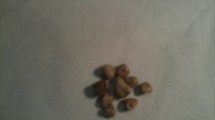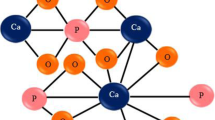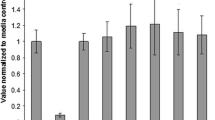Abstract
Phyllanthus niruri is a plant used in Brazilian folk medicine for the treatment of urolithiasis. It was previously observed that P. niruri shows no toxicity, potentially increases calculus voiding by stone forming patients and inhibits the endocytosis of calcium oxalate (CaOx) crystals by MDCK cells. In addition, in a rat model of urolithiasis it reduced calculus growth. In the present study, we evaluated the effect of an aqueous extract of P. niruri on CaOx crystallization in vitro. CaOx precipitation was induced by the addition of 0.1 M sodium oxalate to unfiltered urine samples from Wistar rats (n=14) and normal humans (n=18) in the presence or absence of P. niruri extract (0.25 mg/ml of urine). The presence of CaOx crystals was evaluated immediately and 24 h later. In vitro crystallization of human urine produced typical mono- and dihydrated CaOx crystals, but only a few typical CaOx crystals were found in rat urine. The presence of P. niruri extract did not inhibit CaOx precipitation and even more crystals were obtained, although they were significantly smaller than those in the control urine. Crystal aggregation observed 24 h after crystallization was also inhibited by P. niruri extract. The results showed an inhibitory effect of P. niruri extract on CaOx crystal growth and aggregation in human urine, suggesting that it may interfere with the early stages of stone formation and may represent an alternative form of treatment and/or prevention of urolithiasis





Similar content being viewed by others
References
Atmani F, Khan SR (2000) Effects of an extract from Herniaria hirsuta on calcium oxalate crystallization in vitro. BJU Int 85:621
Bushinski DA, Grynpas MD, Nilsson EL, Nakagawa Y, Coe FL (1995) Stone formation in genetic hypercalciuric rats. Kidney Int 48:1705
Calixto JB, Yunes RA, Neto AS, Valle RM, Rae GA (1984) Antispasmodic effects of an alkaloid extracted from Phyllanthus sellowianus: a comparative study with papaverine. Braz J Med Biol Res 17:313
Calixto JB, Santos AR, Cechinel Filho V, Yunes RA (1998) A review of the plants of the genus Phyllanthus: their chemistry, pharmacology, and therapeutic potential. Med Res Rev 18:225
Campos AH, Schor N (1999) Phyllanthus Niruri inhibits calcium oxalate endocytosis by renal tubular cells: Its role in urolithiasis. Nephron 81:393
Cifuentes DL (1991) Alkalinizing treatment as preventative of recurrent calcium oxalate lithiasis. Arch Esp Urol 44:903
Coe FL, Parks JH, Nakagauwa Y (1992) Inhibitors and promoters of calcium oxalate crystallization: their relationship to the pathogenesis and treatment of nephrolithiasis. In: Coe FL, Parks JH, Nakagauwa Y (eds) Disorders of bone and mineral metabolism. Raven Press, New York, pp 757
Dussol B, Berland Y (1998) Urinary kidney stone inhibitors. What is new? Urol Int 60:69
Dyer R, Nordin BE (1967) Urinary crystals and their relation to stone formation. Nature 215:751
Finlayson B (1974) Symposium in renal lithiasis. Renal lithiasis in review. Urol Clin North Am 1:181
Freitas AM, Carvente CT, Schor N, Boim MA (2000) The effect of Phyllanthus niruri on urinary excretion of endogenous inhibitors of lithogenesis. In Rodgers AL, Hibbert BE, Hess B, Khan SR, Preminger GM (eds) Proceedings of Ninth International Symposium on Urolithiasis vol 1. Cape Town, p 183
Høgaard I, Fornander AM, Nilsson MA, Tiselius HG (1999) The effect of pH changes on the crystallization of calcium salts in solutions with an ion composition corresponding to that in the distal tubule. Urol Res 27:409
Joshi BS, Gawad DH, Pelletier SW, Kartha G, Bhandary K (1986) Isolation and structure (X-ray analysis) of ent-norsecurinine, an alkaloid from Phyllanthus niruri. J Nat Prod 49:614
Khan SR, Hackett RL (1985) Calcium oxalate urolithiasis in the rat: is it a model for human stone disease? A review of recent literature. Scanning Electron Microsc 2:759
Leusmann DB, Niggemann H, Roth S, Von Ahlen H (1995) Recurrence rates and severity of urinary calculi. Scand J Urol Nephrol 29:279
Lieske JC, Deganello S, Toback FG (1999) Cell-crystal interactions and kidney stone formation. Nephron 81 [Suppl 1]:8
Mandel N (1994) Crystal membrane interaction in kidney stone disease. J Am Soc Nephrol 5 [Supp 1]:S37
Mello JF (1980) Plants in traditional medicine in Brazil. J Ethnopharmacol 2:49
Melo EMA, Coelho STNS, Santos DR, Ajzen H, Schor N (1991) Urolitiase experimental: Avaliação do efeito do chá de quebra-pedra (Phyllanthus niruri). J Bras Nefrol 13:26
Ogata T, Higuchi H, Mochida S, Matsumoto H, Kato A, Endo T, Kaji A, Kaji H. (1992) HIV-1 reverse transcriptase inhibitor from Phyllanthus niruri. AIDS Res Hum Retroviruses 8:1937
Paulino N, Cechinel-Filho V, Yunes RA, Calixto JB (1996) The relaxant effect of extract of Phyllanthus urinaria in the Guinea-pig isolated trachea. Evidence for involvement of ATP sensitive potassium channels. J Pharm Pharmacol 48:1158
Ryall RL, Bagley CJ, Marshall VR (1981) Independent assessment of the growth and aggregation of calcium oxalate crystals using the Coulter counter. Investig Urol (Berl) 18:401
Ryall RL, Harnett RM, Marshall VR (1981) The effect of urine, pyrophosphate, citrate, magnesium of calcium crystals in vitro. Clin Chim Acta 112:349
Santos AR, Filho VC, Niero R, Viana AM, Moreno FN, Campos MM, Yunes RA, Calixto JB (1994) Analgesic effects of callus culture extracts from selected species of Phyllanthus in mice. J Pharm Pharmacol 46:755
Santos DR, Schor N. Produtos naturais no tratamento da nefrolitíase. In Schor N, Heilberg IP (1995) Calculose renal: fisiopatologia, diagnóstico e tratamento. Sarvier, São Paulo, p 221
Saso L, Valentine G, Casini ML, Mahei E, Panzironi C, Silvestrini B (1998) Development of a turbidimetric assay to study the effect of urinary components on calcium oxalate precipitation. Urol Int 60:47
Sowers MR, Jannuasch M, Wood C, Pope SK, Lalhance LL, Peterson B (1998) Prevalence of renal stones in a population based study with dietary calcium, oxalate and medication exposures. Am J Epidemiol 147:914
Trivedi BK (1996) Nephrolithiasis. Postgrad Med 100:63
Wassertein AG (1998) Nephrolithiasis: acute management and prevention. Dis Mon 44:196
Wesson JA, Worcester EM, Wiessner JH, Mandel NS, Kleinmam JG (1998) Control of calcium oxalate crystal structure and cell adherence by urinary macromolecules. Kidney Int 53:952
Worcester EM (1996) Inhibitors of stone formation. Semin Nephrol 5:474
Acknowledgements.
We are indebted to Dr. A.J. Lapa, Pharmacology Department, Universidade Federal de São Paulo, for preparing the lyophilized form of Phyllanthus niruri. This study was supported by Fundação de Amparo à Pesquisa (FAPESP), Coordenação de Aperfeiçoamento de Nível Superior (CAPES), Conselho Nacional Científico Tecnológico (CNPq) and Fundação Oswaldo Ramos.
Author information
Authors and Affiliations
Corresponding author
Rights and permissions
About this article
Cite this article
Barros, M.E., Schor, N. & Boim, M.A. Effects of an aqueous extract from Phyllantus niruri on calcium oxalate crystallization in vitro. Urol Res 30, 374–379 (2003). https://doi.org/10.1007/s00240-002-0285-y
Received:
Accepted:
Published:
Issue Date:
DOI: https://doi.org/10.1007/s00240-002-0285-y




